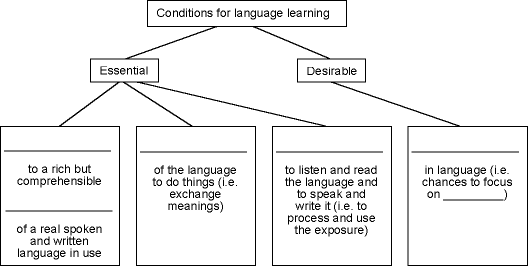Summary
So far we have identified three essential conditions for language acquisition: these are … can you recall? (see Commentary 4.1.4)
In addition, there is one other factor that is especially desirable. This is… can you recall? (see Commentary 4.1.5)
4.1.3.1
Instruction and TBL
4.1.3.2 Diagram of SLA conditions
4.1.3.3 Concluding comments
4.1.3.1
Instruction and TBL
In this video clip, Jane Willis explains
what is meant by instruction in the context of a task-based lesson (see
Transcript JW02).
4.1.3.2
Diagram of SLA conditions
Jane Willis (1996: 11) presents these SLA conditions in the form of a
diagram. Print or copy this version (see Assessment task 4.1.7)
and fill in the gaps.

Need some help? See Commentary 4.1.6 for the missing words (note they are not in the right order - you can work that out!)
4.1.3.3
Concluding comments
The 'four conditions for language learning' presented here have been proposed
by Jane Willis (1996). They represent
a distillation of recent thinking and theory of second language acquisition
and instructed second language learning from a number of researchers and
writers in the field. You may be familiar with Krashen's (1981)
'Monitor Hypothesis', for example, which proposed the concept of meaningful
input or exposure. This was developed by Swain (1985),
who introduced the idea of comprehensible output (sometimes called 'pushed
output'), and Ellis (eg 1999), among
others, has written much on the topic of instruction. The 'four conditions'
are, therefore, a simplification of a highly complex area, but as a set
of 'rules of thumb' which can inform teachers and materials designers
they represent a useful summary of the key considerations in this area,
and frequent reference will be made to them in the following activity
cycles.